A Simple and Robust Method for Simultaneous Consideration of Overland and Underground Space in Urban Flood Modeling
Abstract
:1. Introduction
2. Methods
2.1. Urban Flood Inundation Model
2.2. Methods to Link Overland and Underground Spaces
3. Applications and Results
3.1. Study Area
3.2. SWMM Calibration
3.3. Urban Flood Analysis
3.3.1. Model Scenarios
3.3.2. 2D Flood Analysis Linking the Overland and Underground Spaces
4. Conclusions
- The water depths measured at two covered streams were used for calibration of the conduit roughness coefficient in the SWMM. When = 0.02 was applied, a RMSE and RPE of the calculated and observed water depth at two streams were about 2.32 cm and 3.92%, respectively, showing the highest accuracy. In addition, surface roughness coefficient of 2D flood model was calibrated by minimizing the difference between measured and calculated flood extent, and = 0.025 presenting the highest goodness of fit (74.2%) was selected as an optimal roughness coefficient. In addition, in order to overcome the problem of the measured flood extent not being accurately investigated, flood damage report regions of residents, press media articles, and photos showing real situations as well as measured flood depth were additionally used.
- The boundary-type (Case 2) and pond-type (Case 3) to link overland and underground spaces by considering floodwater flowed into the underground space were proposed. The predictions of Cases 2 and 3 were compared with those of Case 1 considering only overland flow to examine the effect of underground space in the urban flood modeling. Regardless of the consideration of the underground space, mean flood depth, mean velocity, and maximum flood depth showed similar results, whereas flood extent and maximum velocity of Cases 2 and 3 were approximately 12% smaller and 30% faster, respectively, than those of Case 1.
- Both of the boundary-type and pond-type presented more accurate in the predictions of flood extent and flood depth as compared with Case 1 not considering underground space. A model execution time of the boundary-type was similar to that of Case 1, whereas the pond-type took more execution time than the other cases. These results indicate that the boundary-type is simple but robust method with high computational efficiency for simultaneous consideration of overland and underground space in urban flood modeling. Thus, the boundary-type in urban flood modeling is expected to be usefully applied when accurate and fast flood information is required regionally such as urban flood responses, measures and planning or flood insurance.
Acknowledgments
Author Contributions
Conflicts of Interest
References
- Djordjević, S.; Prodanović, D.; Maksimović, Č. An approach to simulation of dual drainage. Water Sci. Technol. 1999, 39, 95–103. [Google Scholar] [CrossRef]
- Mark, O.; Weesakul, S.; Apirumanekul, C.; Aroonnet, S.B.; Djordjević, S. Potential and limitations of 1D modelling of urban flooding. J. Hydrol. 2004, 299, 284–299. [Google Scholar] [CrossRef]
- Djordjević, S.; Prodanović, D.; Maksimović, C.; Ivetić, M.; Savić, D. SIPSON-Simulation of interaction between pipe flow and surface overland flow in networks. Water Sci. Technol. 2005, 52, 275–283. [Google Scholar] [PubMed]
- Schmitt, T.G.; Thomas, M.; Ettrich, N. Assessment of Urban flooding by dual drainage simulation model RisUrSim. Water Sci. Technol. 2005, 52, 264–274. [Google Scholar]
- Maksimović, Č.; Prodanović, D.; Boonya-Aroonnet, S.; Leitão, J.P.; Djordjević, S.; Allitt, R. Overland flow and pathway analysis for modelling of urban pluvial flooding. J. Hydraul. Res. 2009, 47, 512–523. [Google Scholar] [CrossRef]
- Leandro, J.; Chen, A.; Djordjević, S.; Savić, D.D.A. Comparison of 1D/1D and 1D/2D coupled (Sewer/Surface) hydraulic models for urban flood simulation. J. Hydraul. Eng. 2009, 135, 495–504. [Google Scholar] [CrossRef]
- Pina, R.D.; Ochoa, S.; Simões, N.E.; Mijic, A. Semi- vs. Fully-distributed urban stormwater models: Model set up and comparison with two real case studies. Water 2016, 8, 58. [Google Scholar] [CrossRef]
- Casas, A.; Benito, G.; Thorndycraft, V.R.; Rico, M. The topographic data source of digital terrain models as a key element in the accuracy of hydraulic flood modelling. Earth Surf. Process. Landf. 2006, 31, 444–456. [Google Scholar] [CrossRef]
- Van de Sande, B.; Lansen, J.; Hoyng, C. Sensitivity of coastal flood risk assessments to digital elevation models. Water 2012, 4, 568–579. [Google Scholar] [CrossRef]
- Shoji, F.; Mikio, K. Prediction of flood-induced flows in urban residential areas and damage reduction. In Proceedings of the International Workshop on Floodplain Risk Management, Hiroshima, Japan, 11–13 November 1996.
- Mirei, S.; Juichiro, A. Numerical and experimental study on 2-D flood flows with and without structures. J. Hydraul. Eng. 2003, 129, 817–821. [Google Scholar]
- Alcrudo, F. Mathematical Modelling Techniques for Flood Propagation in Urban Areas; IMPACT Project Technical Report: Wallingford, UK, January 2004. [Google Scholar]
- Marks, K.; Bates, P. Integration of high-resolution topographic data with floodplain flow models. Hydrol. Process. 2000, 14, 2109–2122. [Google Scholar] [CrossRef]
- Vojinovic, Z.; Seyoum, S.D.; Mwalwaka, J.M.; Price, R.K. Effects of model schematization, geometry and parameter values on urban flood modelling. Water Sci. Technol. 2011, 63, 462–467. [Google Scholar] [CrossRef] [PubMed]
- Fewtrell, T.J.; Duncan, A.; Sampson, C.C.; Neal, J.C.; Bates, P.D. Benchmarking urban flood models of varying complexity and scale using high resolution terrestrial LiDAR data. Phys. Chem. Earth A/B/C 2011, 36, 281–291. [Google Scholar] [CrossRef]
- Turner, A.B.; Colby, J.D.; Csontos, R.M.; Batten, M. Flood modeling using a synthesis of multi-platform LiDAR data. Water 2013, 5, 1533–1560. [Google Scholar] [CrossRef]
- Mason, D.C.; Giustarini, L.; Garcia-Pintado, J.; Cloke, H.L. Detection of flooded urban areas in high resolution synthetic aperture radar images using double scattering. Int. J. Appl. Earth Obs. Geoinf. 2014, 28, 150–159. [Google Scholar] [CrossRef]
- Leitão, J.P.; Moy de Vitry, M.; Scheidegger, A.; Rieckermann, J. Assessing the quality of digital elevation models obtained from mini unmanned aerial vehicles for overland flow modelling in urban areas. Hydrol. Earth Syst. Sci. 2016, 20, 1637–1653. [Google Scholar] [CrossRef]
- Chen, A.S.; Evans, B.; Djordjević, S.; Savić, D.A. Multi-layered coarse grid modelling in 2D urban flood simulations. J. Hydrol. 2012, 470–471, 1–11. [Google Scholar] [CrossRef]
- Yu, D.; Lane, S.N. Urban fluvial flood modelling using a two-dimensional diffusion-wave treatment, part 2: Development of a sub-grid-scale treatment. Hydrol. Process. 2006, 20, 1567–1583. [Google Scholar] [CrossRef]
- Yu, D.; Lane, S.N. Interactions between subgrid-scale resolution, feature representation and grid-scale resolution in flood inundation modelling. Hydrol. Process. 2011, 25, 36–53. [Google Scholar] [CrossRef]
- Fewtrell, T.J.; Bates, P.D.; Horitt, M.; Hunter, N.M. Evaluating the effect of scale in flood inundation modelling in urban environments. Hydrol. Process. 2008, 22, 5107–5118. [Google Scholar] [CrossRef]
- McMillan, H.K.; Brasington, J. Reduced complexity strategies for modelling urban floodplain inundation. Geomorphology 2007, 90, 226–243. [Google Scholar] [CrossRef]
- Soares-Frazao, S.; Lhomme, J.; Guinot, V.; Zech, Y. Two-dimensional shallow-water model with porosity for urban flood modelling. J. Hydraul. Res. 2008, 46, 45–64. [Google Scholar] [CrossRef]
- Cea, L.; Vázquez-Cendón, M.E. Unstructured finite volume discretization of two-dimensional depth-averaged shallow water equations with porosity. Int. J. Numer. Methods Fluids 2009, 63, 903–930. [Google Scholar] [CrossRef]
- Guinot, V. Multiple porosity shallow water models for macroscopic modelling of urban floods. Adv. Water Res. 2012, 37, 40–72. [Google Scholar] [CrossRef]
- Kim, B.; Sanders, B.F.; Famiglietti, J.S.; Guinot, V. Urban flood modeling with porous shallow-water equations: A case study of model errors in the presence of anisotropic porosity. J. Hydrol. 2015, 523, 680–692. [Google Scholar] [CrossRef]
- Özgen, I.; Zhao, J.; Liang, D.; Hinkelmann, R. Urban flood modeling using shallow water equations with depth-dependent anisotropic porosity. J. Hydrol. 2016, 541, 1165–1184. [Google Scholar] [CrossRef]
- Abdullah, A.F.; Vojinovic, Z.; Price, R.K.; Aziz, N.A.A. A methodology for processing raw LiDAR data to support urban flood modelling framework. J. Hydroinform. 2012, 14, 75–92. [Google Scholar] [CrossRef]
- Abdullah, A.F.; Vojinovic, Z.; Price, R.K.; Aziz, N.A.A. Improved methodology for processing raw LiDAR data to support urban flood modelling—Accounting for elevated roads and bridges. J. Hydroinform. 2012, 14, 253–269. [Google Scholar] [CrossRef]
- Shon, T.S.; Kang, D.H.; Jang, J.K.; Shin, H.S. A study of assessment for internal inundation vulnerability in urban area using SWMM. J. Korean Soc. Hazard. Mitig. 2010, 10, 105–117. [Google Scholar]
- Kim, B.; Kim, T.H.; Kim, J.H.; Han, K.Y. A well-balanced unsplit finite volume model with geometric flexibility. J. Vibroeng. 2014, 16, 1574–1589. [Google Scholar]
- Seoul Metropolitan City (SMC). Environment White Paper: Environment of Seoul; Seoul Metropolitan City Press: Seoul, Korea, 2014. [Google Scholar]
- Kim, H.S. A Study on the Decision of Design Magnitude for Flood Control of Urban Basin Based on Flooding Characteristic Values: A Case Study on the Hyoja Drainage Basin, Located in Cheonggyecheon Basin in Seoul. Master’s Thesis, University of Yonsei, Seoul, Korea, 2012. [Google Scholar]
- Lee, J.T.; Hur, S.C.; Kim, T.H. Sensitivity analysis of the SWMM model parameters based on design rainfall condition. J. Korea Water Resour. Assoc. 2005, 38, 213–222. [Google Scholar] [CrossRef]
- Kim, B.; Sanders, B.F.; Han, K.Y.; Kim, Y.J.; Famiglietti, J.S. Calibration of stormwater management model using flood extent. Proc. ICE Water Manag. 2014, 167, 17–29. [Google Scholar] [CrossRef]
- Korean Water Resources Association (KWRA). River Design Criteria; Korean Water Resources Association: Seoul, Korea, 2009. [Google Scholar]
- Yi, C.Y.; An, S.M.; Kim, K.R.; Choi, Y.J.; Dieter, S. Improvement of air temperature analysis by precise spatial data on local-scale: A case study of Eunpyeong Newtown in Seoul. J. Korean Assoc. Geogr. Inf. Stud. 2012, 15, 144–158. [Google Scholar] [CrossRef]
- Urban Flood Disaster Management Research Center (UFDMRC). A Guideline on Flood Estimation in Urban Area: FFC06-1; Urban Flood Disaster Management Research Center: Seoul, Korea, 2008. [Google Scholar]
- Bates, P.D.; Dawson, R.J.; Hall, J.W.; Horritt, M.S.; Nicholls, R.J.; Wicks, J.; Hassan, M.A.A.M. Simplified two-dimensional numerical modelling of coastal flooding and example applications. Coast. Eng. 2005, 52, 793–810. [Google Scholar] [CrossRef]
- Schubert, J.E.; Sanders, B.F. Building treatments for urban flood inundation models and implications for predictive skill and modeling efficiency. Adv. Water Resour. 2012, 41, 49–64. [Google Scholar] [CrossRef]
- Smith, R.A.E.; Bates, P.D.; Hayes, C. Evaluation of a coastal flood inundation model using hard and soft data. Environ. Model. Softw. 2012, 30, 35–46. [Google Scholar] [CrossRef]
- Wadey, M.P.; Nicholls, R.J.; Hutton, C. Coastal flooding in the Solent: An integrated analysis of defences and inundation. Water 2012, 4, 430–459. [Google Scholar] [CrossRef]

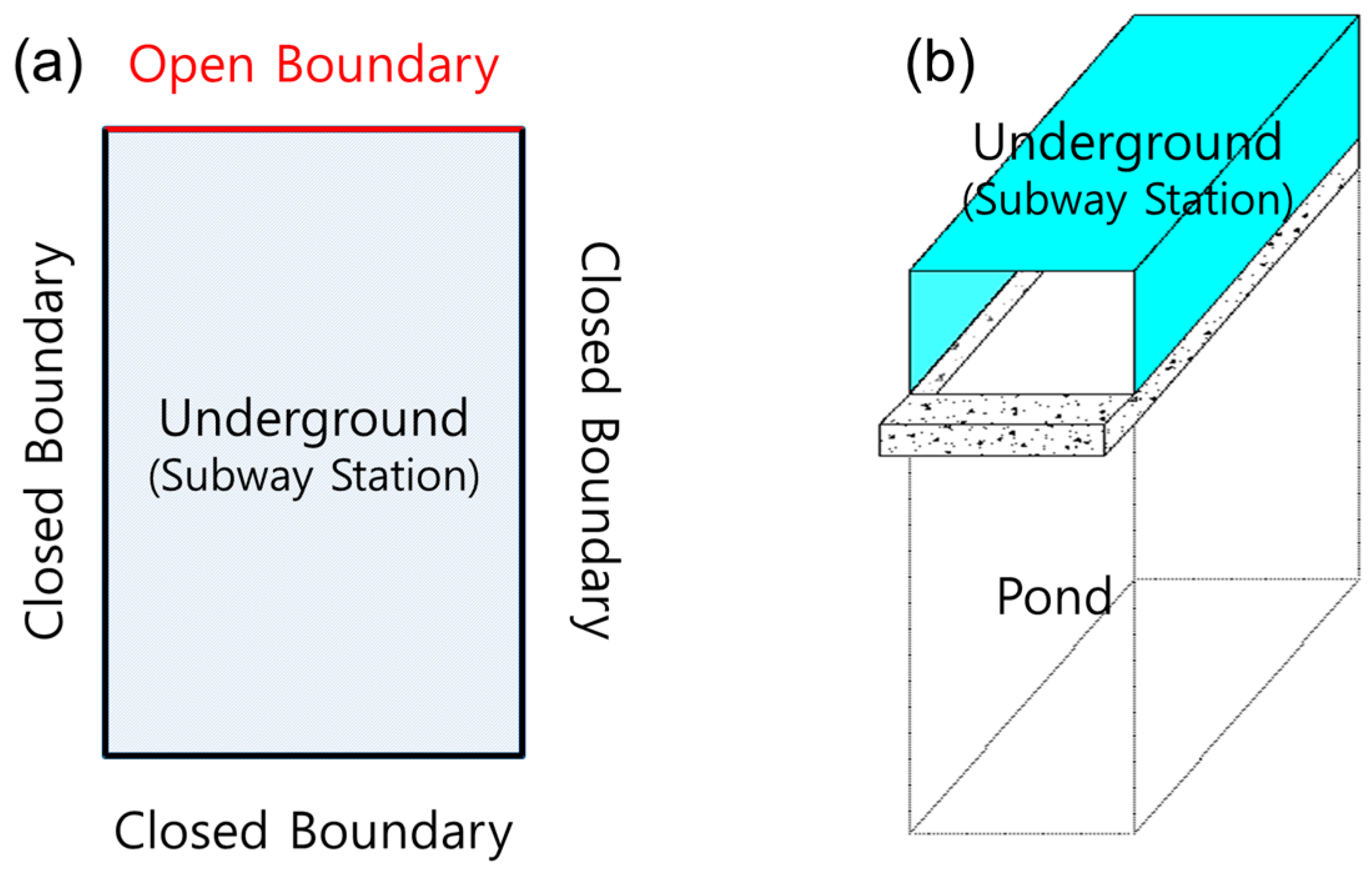

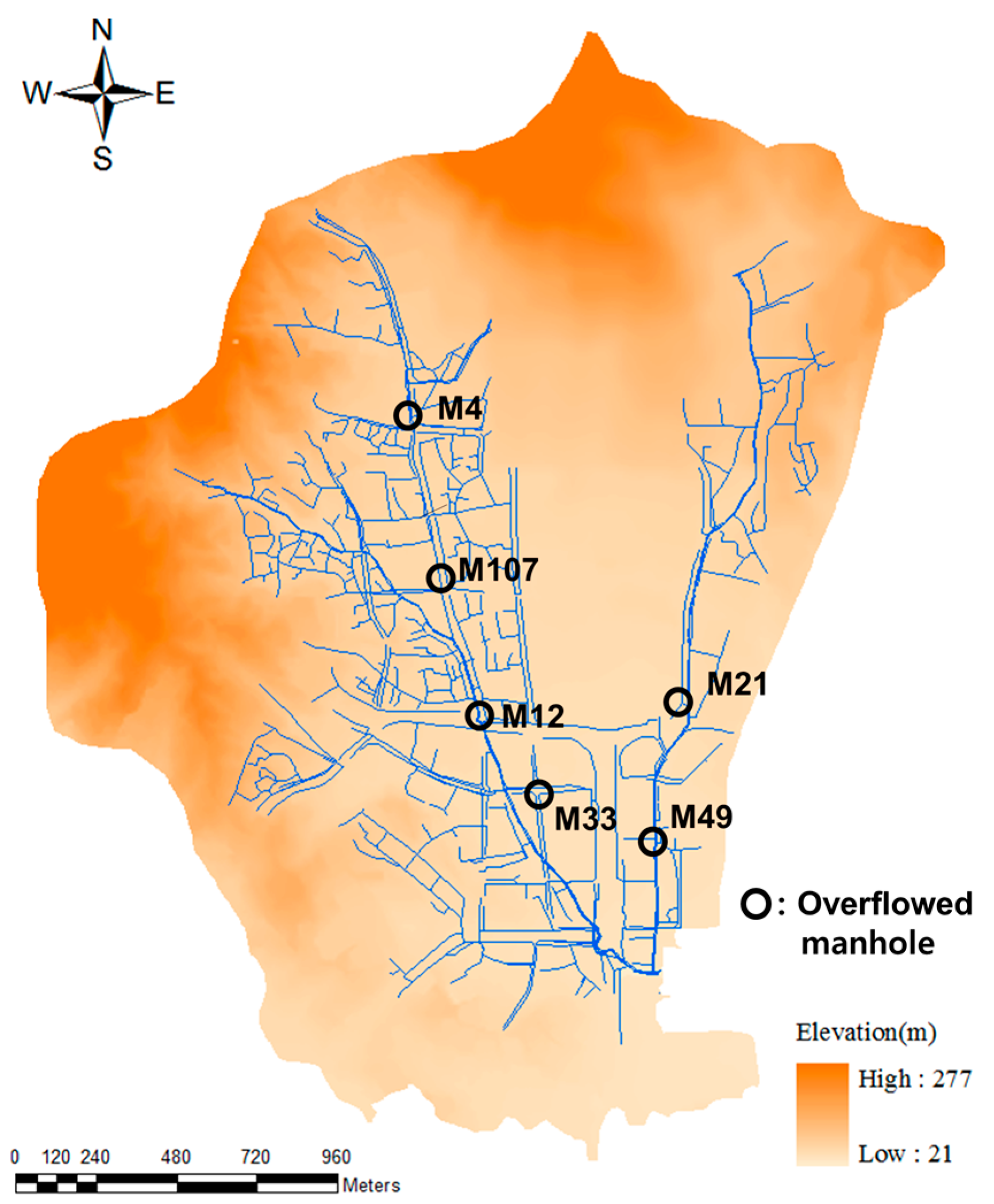


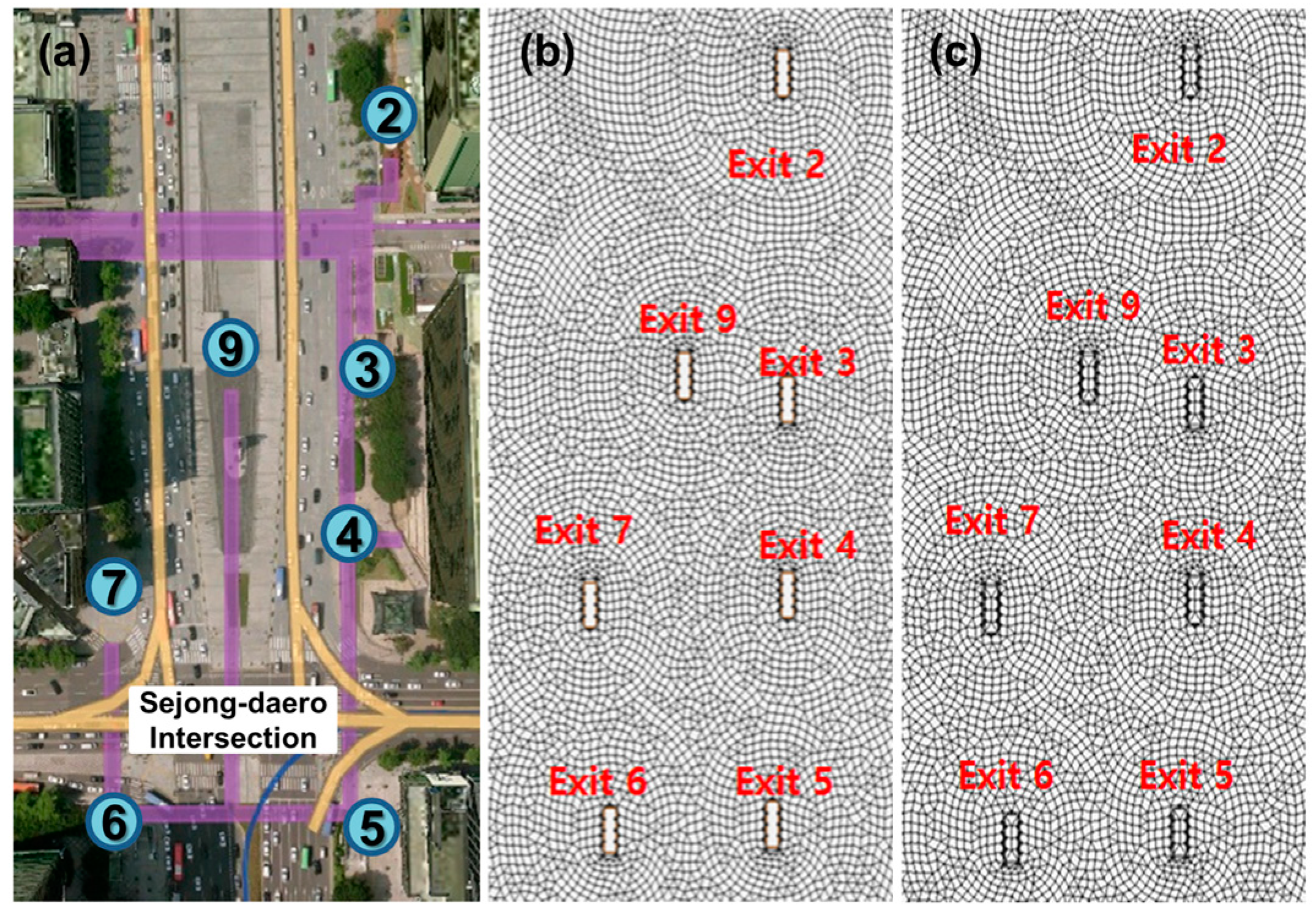

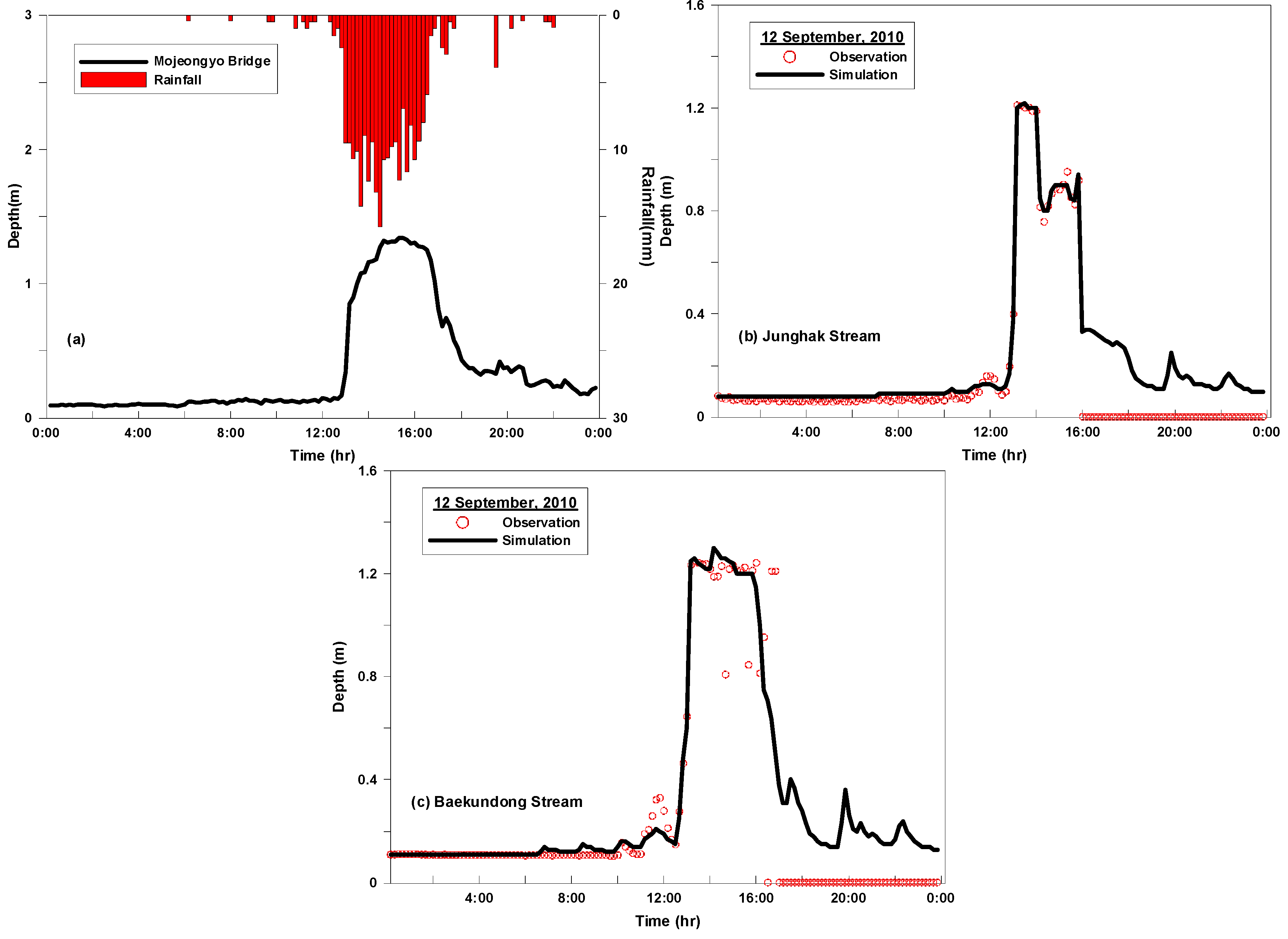

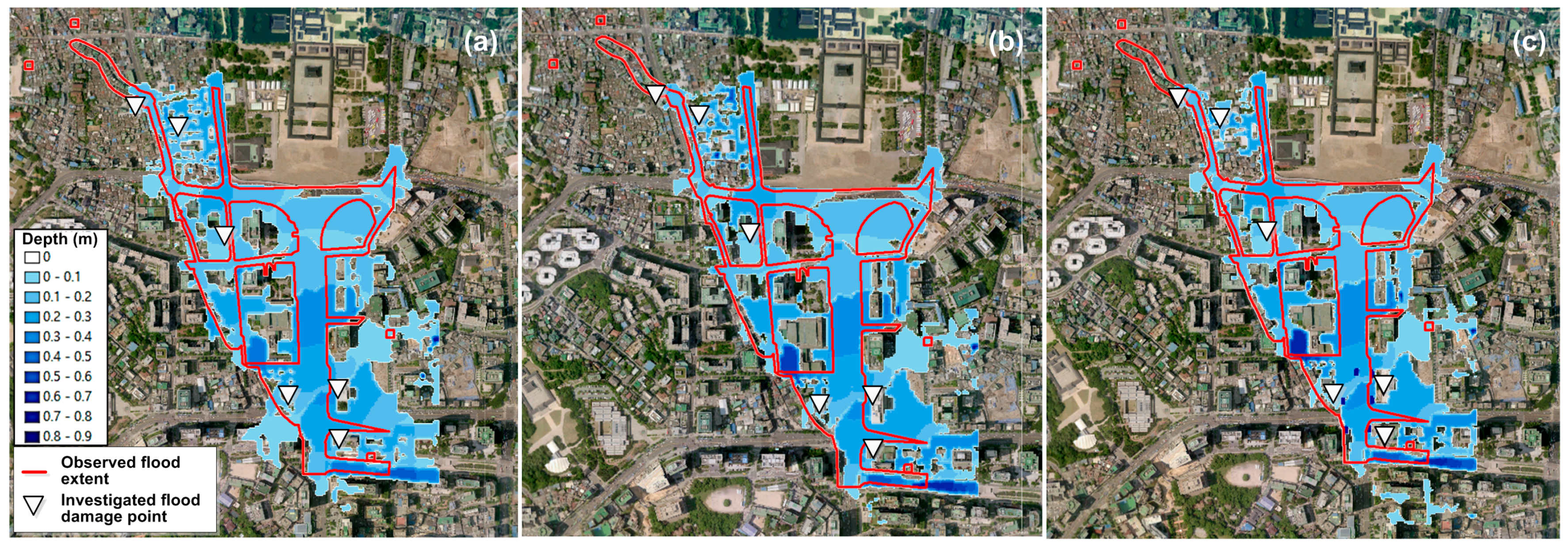



| Error | 12 June 2010 | 27 August 2010 | ||
|---|---|---|---|---|
| Junghak | Baekundong | Junghak | Baekundon | |
| RMSE (cm) | 2.29 | 1.88 | 2.27 | 2.87 |
| RPE (%) | 6.38 | 1.75 | 2.04 | 5.52 |
| Exit No. | 2 | 3 | 4 | 5 | 6 | 7 | 9 |
|---|---|---|---|---|---|---|---|
| Height (m) | 0.22 | 0.10 | 0.33 | 0.49 | 0.32 | 0.29 | 0.0 |
| Fit (%) | Surface Manning’s Roughness Coefficient (m−1/3s) | |||
|---|---|---|---|---|
| 0.015 | 0.020 | 0.025 | 0.030 | |
| Goodness of fit | 39.52 | 39.88 | 40.22 | 40.11 |
| Modified goodness of fit | 73.6 | 73.9 | 74.2 | 74.0 |
| Case | Case 1 | Case 2 | Case 3 |
|---|---|---|---|
| Goodness of fit (%) | 74.2 | 82.7 | 84.2 |
| Avg. depth (m) | 0.04 | 0.06 | 0.05 |
| Max. depth (m) | 1.01 | 0.96 | 0.98 |
| Avg. velocity (m/s) | 0.10 | 0.09 | 0.09 |
| Max. velocity (m/s) | 1.77 | 2.30 | 2.47 |
| Execution time (min) | 426 | 514 | 1865 |
| Difference | Depth (m) | Velocity (m/s) | ||||
|---|---|---|---|---|---|---|
| Min. | Max. | Mean | Min. | Max. | Mean | |
| Case 1–Case 2 | −0.71 | 0.60 | 0.006 | −1.35 | 0.77 | 0.012 |
| Case 1–Case 3 | −0.73 | 0.33 | 0.004 | −1.48 | 0.74 | 0.008 |
© 2016 by the authors; licensee MDPI, Basel, Switzerland. This article is an open access article distributed under the terms and conditions of the Creative Commons Attribution (CC-BY) license (http://creativecommons.org/licenses/by/4.0/).
Share and Cite
Son, A.-L.; Kim, B.; Han, K.-Y. A Simple and Robust Method for Simultaneous Consideration of Overland and Underground Space in Urban Flood Modeling. Water 2016, 8, 494. https://doi.org/10.3390/w8110494
Son A-L, Kim B, Han K-Y. A Simple and Robust Method for Simultaneous Consideration of Overland and Underground Space in Urban Flood Modeling. Water. 2016; 8(11):494. https://doi.org/10.3390/w8110494
Chicago/Turabian StyleSon, Ah-Long, Byunghyun Kim, and Kun-Yeun Han. 2016. "A Simple and Robust Method for Simultaneous Consideration of Overland and Underground Space in Urban Flood Modeling" Water 8, no. 11: 494. https://doi.org/10.3390/w8110494
APA StyleSon, A.-L., Kim, B., & Han, K.-Y. (2016). A Simple and Robust Method for Simultaneous Consideration of Overland and Underground Space in Urban Flood Modeling. Water, 8(11), 494. https://doi.org/10.3390/w8110494






